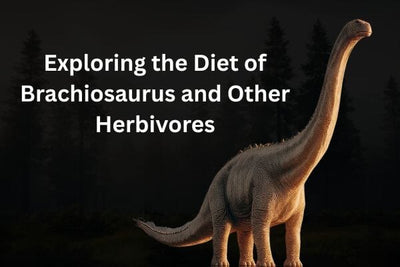Brachiosaurus was one of the tallest animals in the Jurassic period. A lot of people, including scientists, are interested in how it ate and lived. Its feeding style, called the brachiosaurus diet, allowed it to reach leaves that other plant-eaters could not. This gave it an edge over other animals in those old forests. By looking at what Brachiosaurus and other leaf-eaters ate, we see how they lived together and changed their world many years ago.
What Made Brachiosaurus a Specialized Feeder?
Brachiosaurus was a long-necked dinosaur. It had special features that helped it eat leaves from high places. Its neck was so long that it could reach the top of trees. This dinosaur had strong teeth shaped like pegs. These teeth helped it pull off leaves, but were not made for chewing tough things. Some of the most important features are:
-
Height Advantage: The giraffe could get leaves up in the trees. This helped it stay away from competition with other animals that are not as tall.
-
Gastroliths: Swallowed stones that helped grind up plant matter in the stomach for better digestion.
-
Careful Feeding: The giraffe can take the best leaves and soft branches that have more goodness in them.
-
Saving Energy: The giraffe did not move around much when eating. This saved a lot of energy for its large body.
These changes helped Brachiosaurus live well with other plant-eating dinosaurs. Each kind took up its own spot in the environment.
How Did Brachiosaurus Feed Among the Trees?
Brachiosaurus did not eat like other plant-eating dinosaurs that got food from the ground. Fossils show that this dinosaur could reach plants high up in the trees, where other dinosaurs could not get. It spent hours eating without moving a lot. Its jaw and teeth helped it pull leaves off branches fast and easy:
-
Teeth are set up to strip food, not grind it.
-
There is little chewing. Food is swallowed in large amounts to meet the need for calories.
-
It eats all the time to help it stay as big as it is.
This way helped cut down on competition. It lets different types of herbivores live together in the same place.
How Did Other Herbivores Like Diplodocus Share the Ecosystem?
While Brachiosaurus ate leaves from the top of trees, the Diplodocus dinosaur ate plants that grew nearer to the ground and in the middle areas. With its long neck and body that could bend, it could get to shrubs, ferns, and trees that were not too tall. This meant it worked well with Brachiosaurus, instead of fighting to eat the same food.
Layered Feeding:
-
Brachiosaurus: eats leaves and food at the tops of trees
-
Diplodocus: looks for food in the middle of trees
-
Ground-dwelling herbivores: get their food from low plants and bushes
This split in feeding areas allowed the plant-eaters to live together. It also cut down fights for food and other things they needed.
Teeth, Jaws, and Digestive Adaptations: Nature’s Engineering
Beyond just height, their digestive systems function well. Brachiosaurus would have had big fermentation chambers in its gut. This helped it get the most nutrients out of tough plants. Key features:
-
Large Stomachs: Broke down tough plant stuff well through fermentation.
-
Slow Digestion: It took a long time to get energy from leaves that have a lot of cellulose.
-
High Intake: Ate hundreds of kilograms of plants each day.
These changes helped Brachiosaurus keep its huge body working well. They also helped it have enough energy to live and grow.
How Did Seasonal Changes Affect Feeding Habits?
The Mesozoic world changed often. There were seasons that made plants hard to find at times. Plant-eating dinosaurs had to adjust by:
-
Moving to places that have a lot of plants.
-
Changing what they eat, depending on what plants are there.
-
Living well with other plant-eating animals in the same area.
Fossilized teeth and coprolites show that Brachiosaurus and others like it were very good at adjusting. They could change how they ate when changes happened in their surroundings.
What Can Fossils Teach Us About Herbivore Diets?
Modern research, like tooth wear patterns, coprolites, and isotopic analysis, helps us understand what people ate a long time ago:
-
Finds out what plant types they eat and what feeding heights they like.
-
Tells us how their eating habits change the land by choosing certain plants.
-
Shows changes over time, like longer necks and jaws, and how these help them eat.
Through fossils, paleontologists put together how these big plant-eating animals acted, lived, and got along in their world. This helps us see and know what life was like during the Mesozoic time.
Discover Herbivore Fossils at Fossil Age Minerals
Understanding the brachiosaurus diet and other herbivore ways is not just about school studies. It gives you a way to feel close to prehistoric life. Fossil Age Minerals gives you real fossil teeth, bones, and more. All of these help people, teachers, and collectors find out about the diets, actions, and places where these large, ancient animals lived.
Discover their special group of Brachiosaurus, Diplodocus, and other herbivore fossils today. You can hold a part of the Mesozoic time in your hands. Fossil Age Minerals makes sure the fossils are real and that they have the right papers. They help you join the prehistoric world in a good and safe way.


